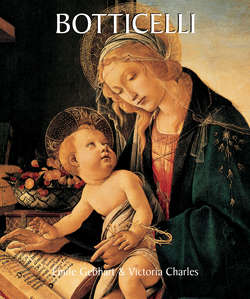Botticelli

Реклама. ООО «ЛитРес», ИНН: 7719571260.
Оглавление
Victoria Charles. Botticelli
Botticelli’s Youth and Education
Botticelli’s First Works
The Medici and Botticelli’s Pagan Initiation
Pagan, Mystical, and Oriental Visions
Botticelli’s Waning Days
Bibliography
Отрывок из книги
1. Self Portrait (detail of the Adoration of the Magi), 1500.
Tempera on wood, 111 × 134 cm.
.....
The Metropolitan Museum of Art, New York.
Vasari tells us that in this time, relations between goldsmiths and painters were intimate and frequent. The trade of goldsmith naturally led to painting. Masolino da Panicale and Paolo Uccello had once been apprentices in the workshop of Ghiberti. And did not many of Botticelli’s famous contemporaries, such as Andrea del Verrocchio and Antonio Pollaiolo wield the file before they touched a brush? Domenico Ghirlandaio was the son of Tommaso, the tinsel maker, whose fingers handled the gold tinsel that young girls used to wreath into their hair in the middle of the century. Andrea del Sarto was later trained in the same art. It was a very Florentine discipline, from which the painters of Florence retained their taste for delicate ornaments as well as for the finesse of their work. The practice of the detailed, scrupulous design, the striving for the most tender, purest, even strange forms, the chatter in the workshop, the proximity of the painters’ workshops, and their delight at the beauty of a sunset, the golden softness of dusk, the austere look of the Apennine mountains washed in dark blue, the faint chimes of distant bells, the farewell to the dying day, which conjured up the memory of the great exiled Florentine Dante – all these impressions were these young men’s labour and leisure at the same time. They helped steer them away from the trade of goldsmith that was honest but limited and rigid in its procedures, and led them onto the footsteps of Masaccio and Filippo Lippi.
.....